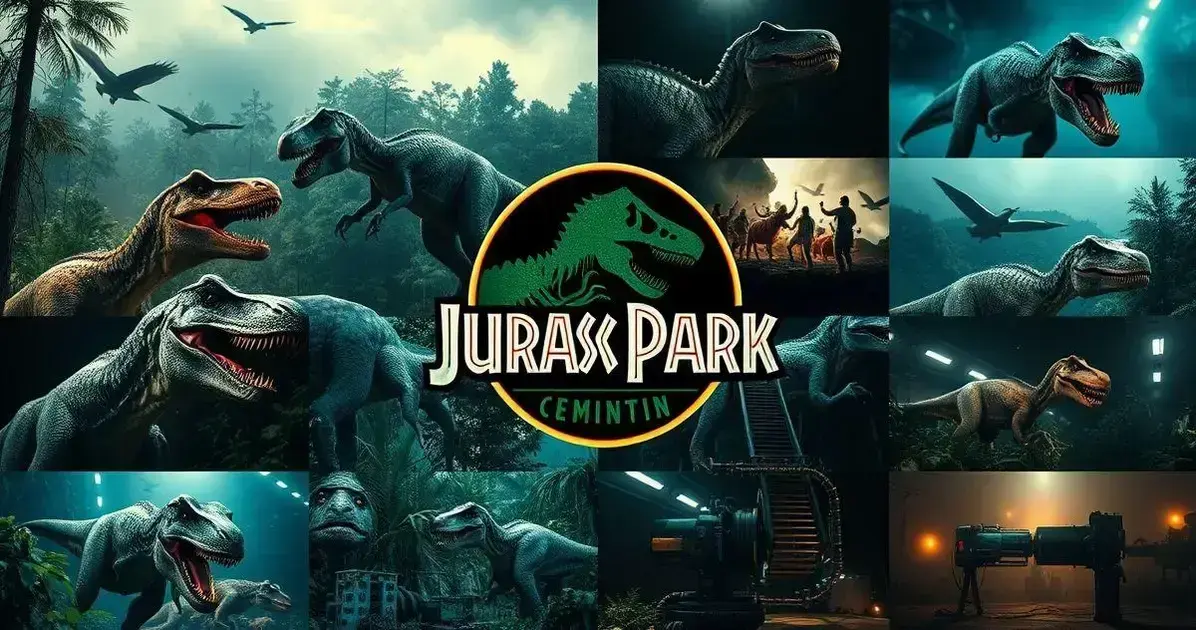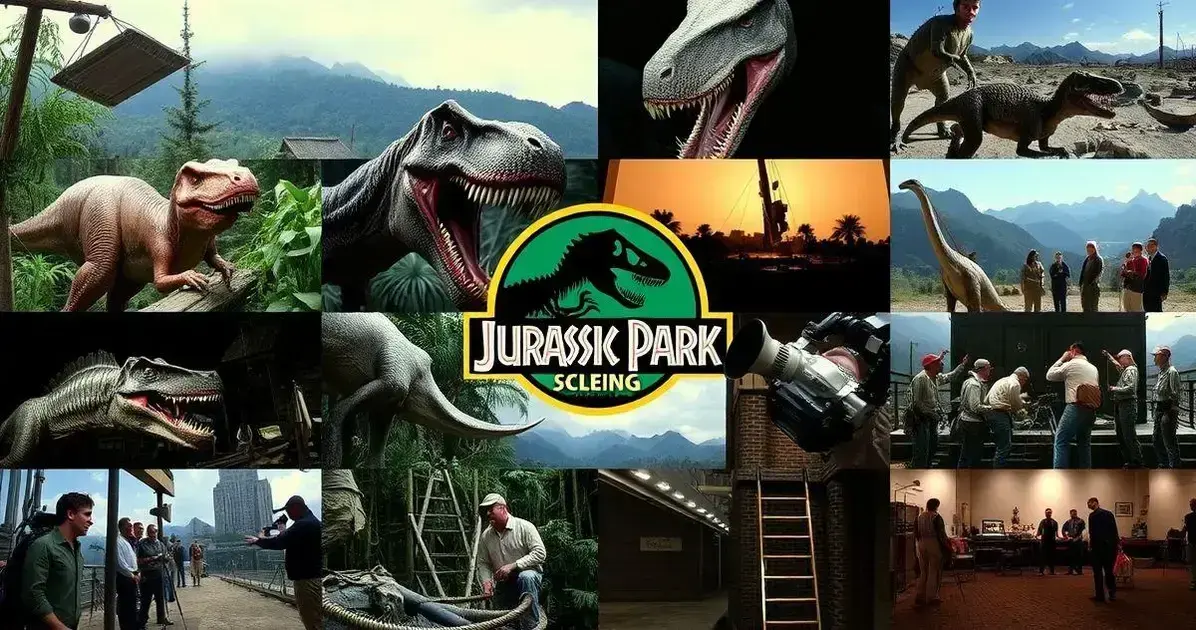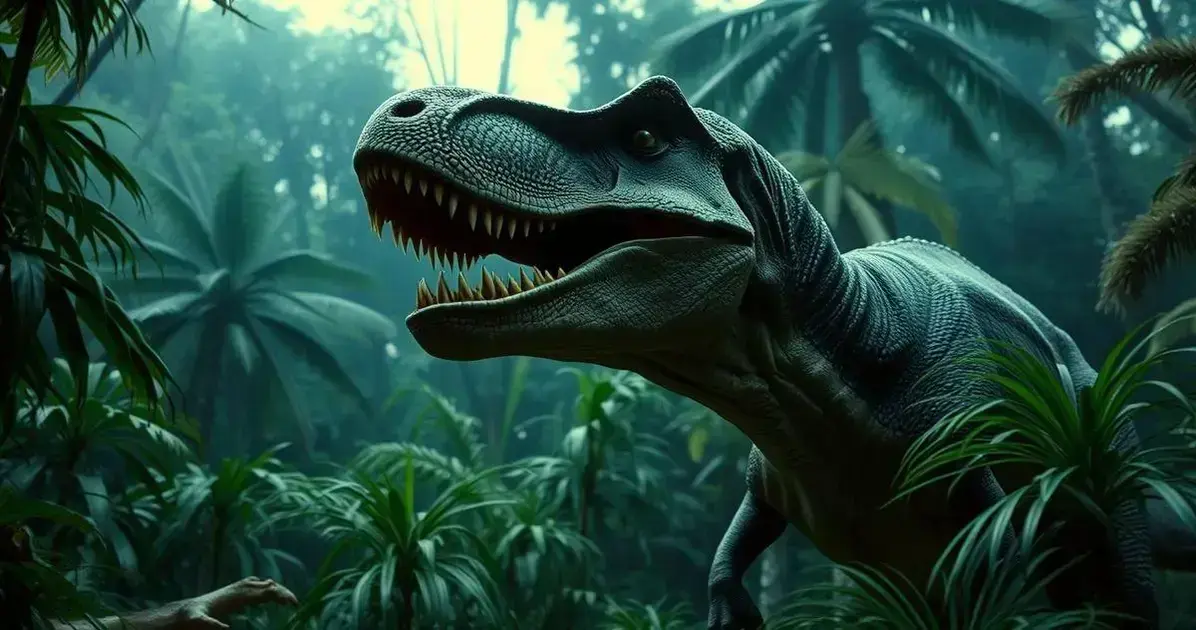Índice
Jurassic Park marked a turning point in cinematic history, leaving audiences in awe with its stunning visuals and gripping narrative. Released in 1993, the film quickly became a classic in the adventure and science fiction genres.
It brought dinosaurs back to life with a realism never seen before, using groundbreaking special effects that set a new standard for Hollywood. The blend of animatronics and CGI was revolutionary, raising the bar for future blockbusters.
Beyond the spectacle, the movie sparked imagination and curiosity about science, nature, and what could be possible. Keep reading to discover how Jurassic Park changed the film industry and why it continues to influence cinema today.
Overview of Jurassic Park Film
The Jurassic Park film was officially released in 1993 and quickly became a cultural phenomenon. Directed by Steven Spielberg, this motion picture adapted Michael Crichton’s novel about a theme park filled with genetically engineered dinosaurs. The film captivated audiences with its thrilling plot and impressive visual effects.
Plot Summary
The story revolves around a group of people invited to an island amusement park where dinosaurs roam. The park is the brainchild of billionaire John Hammond, who believes he has created a safe environment for humans and dinosaurs to coexist. However, things take a turn for the worse when the park’s security systems fail, leading to chaos as dinosaurs run free.
Cinematic Techniques
One of the factors that made the Jurassic Park film groundbreaking was its use of innovative special effects and state-of-the-art CGI. The film’s blend of practical effects and computer-generated imagery created lifelike dinosaurs that thrilled viewers. This approach set a new standard for visual storytelling, influencing countless films that followed.
Critical Reception
Upon its release, the Jurassic Park film received critical acclaim and won multiple Academy Awards. Critics praised the film for its direction, effects, and suspenseful storytelling. Audiences were drawn to the film’s ability to mix adventure, science fiction, and horror, making it widely popular across various demographics.
Box Office Performance
With a box office gross of over $1 billion, the Jurassic Park film broke records and became the highest-grossing film of its time. Its success laid the groundwork for a franchise that includes several sequels, spin-offs, and merchandise.
Legacy
The impact of the Jurassic Park film remains significant in the film industry today. It not only redefined the science fiction genre but also brought attention to the potential consequences of genetic engineering. The film sparked discussions about ethical considerations and has continued to resonate in popular culture, inspiring new generations of filmmakers.
Key Characters in Jurassic Park
The Jurassic Park film features several key characters that drive the story and engage viewers. Each character plays a vital role in the unfolding events on Isla Nublar.
Alan Grant
Dr. Alan Grant, portrayed by Sam Neill, is a renowned palaeontologist and the film’s main protagonist. He is initially sceptical about the park and its safety, focusing on the scientific aspects of dinosaurs. Throughout the film, Alan showcases his knowledge and bravery in confronting the dangers presented by the dinosaurs.
Ellie Sattler
Dr. Ellie Sattler, played by Laura Dern, is a palaeobotanist and Grant’s colleague. She is strong-willed and resourceful, often using her intellect to navigate the challenges they face on the island. Ellie works alongside Alan to uncover the park’s compromises and support the other characters during pivotal moments.
John Hammond
John Hammond, portrayed by Richard Attenborough, is the ambitious founder of Jurassic Park. He embodies the excitement and ambition of scientific advancement but is blinded by his desire for success. Hammond’s vision for a dinosaur theme park drives the plot, but his naivety leads to devastating consequences.
Ian Malcolm
Dr. Ian Malcolm, played by Jeff Goldblum, is a mathematician and chaos theory expert. He frequently warns about the unpredictability of science and the consequences of humans trying to control nature. Malcolm’s witty and charismatic personality brings levity to the tension within the group.
Tim and Lex Murphy
Tim and Lex Murphy, portrayed by Joseph Mazzello and Ariana Richards, are the grandchildren of John Hammond. Tim, a dinosaur enthusiast, adds innocence and curiosity to the story, while Lex showcases bravery and resilience, especially in high-stress situations. Their journey throughout the film highlights the stakes and consequences of the park’s failures.
Henry Wu
Dr. Henry Wu, played by BD Wong, is the chief geneticist behind the dinosaurs. He plays a pivotal role in the scientific explanations of how the dinosaurs were brought to life. Wu’s ambition and ethical dilemmas add complexity to the narrative, as he grapples with the impact of his creations.
These key characters in the Jurassic Park film not only drive the plot but also embody various themes, making the movie a multifaceted experience for audiences.
The Technological Innovations of Jurassic Park

The Jurassic Park film is not just famous for its thrilling plot; it also features several remarkable technological innovations that changed the landscape of filmmaking. These advancements were crucial in bringing the dinosaurs to life and creating an immersive experience for the audience.
Groundbreaking Visual Effects
One of the most notable innovations was the integration of computer-generated imagery (CGI) with practical effects. The team used CGI to create realistic dinosaurs that roamed the screen. This technology was almost revolutionary at the time, allowing filmmakers to depict creatures with unprecedented detail and realism.
Animatronics
In addition to CGI, Jurassic Park relied heavily on animatronics. These mechanical models of dinosaurs were created by Stan Winston’s team. This combination of animatronic and digital effects allowed for various interactions, making scenes like the T-Rex attack all the more believable.
Sound Design
Sound played a crucial role in enhancing the experience of the film. The sound design, led by Gary Rydstrom, involved unique recordings and manipulation of animal sounds to create the roars and movements of the dinosaurs. This attention to audio detail added a significant layer of depth to the viewing experience.
Digital Compositing
Another key innovation was the use of digital compositing. This process allowed filmmakers to combine live-action footage with CGI seamlessly. It enabled the integration of actors with dinosaurs in a way that made interactions feel genuine and engaging.
Camera Technology
Advanced camera techniques were also utilized in the Jurassic Park film. Specialized rigs and dynamic camera movements enhanced the sense of scale and excitement during action sequences. Techniques such as the “dolly zoom” helped create a feeling of suspense and horror during key moments.
Environmental Design
The creation of Isla Nublar also showcased innovative set designs and location shooting. Visual artists used real locations combined with CGI backgrounds to build a believable and immersive world. This contributed to the film’s sense of scale and realism, making viewers truly believe they were in a world where dinosaurs roamed free.
These technological innovations in the Jurassic Park film not only transformed the movie industry but also set new benchmarks for future films in the science fiction and adventure genres.
The Impact of Jurassic Park on Popular Culture
The Jurassic Park film has had a profound impact on popular culture since its release in 1993. Its influence can be seen in various aspects of entertainment, media, and even education.
Merchandising and Franchise Expansion
Following its success, Jurassic Park expanded into a vast franchise that includes toys, video games, and apparel. Iconic dinosaurs, like the T-Rex and Velociraptor, became cultural symbols, appearing in countless forms of merchandise. This further entrenched the film’s significance in the lives of fans worldwide.
Inspiration for Media and Entertainment
The film has inspired numerous documentaries, television series, and novels discussing the science of dinosaurs and genetics. Shows like Walking with Dinosaurs and various educational programmes have drawn upon the public’s interest in dinosaurs that was reignited by Jurassic Park.
Scientific Discussions
Beyond entertainment, the film sparked discussions about genetic engineering, conservation, and the ethics of cloning. It raised questions about humanity’s responsibilities towards nature, making these topics more accessible and engaging for the general public.
Pop Culture References
The Jurassic Park film has deeply embedded itself into pop culture. It has been referenced in various TV shows, films, and internet memes, showcasing its long-lasting relevance. Quotes like “Life finds a way” have become catchphrases, often used in humorous or serious contexts.
Reviving Interest in Dinosaurs
The immense popularity of Jurassic Park revived interest in dinosaurs and paleontology among the public, leading to an increase in visits to museums and educational exhibits showcasing dinosaur fossils. Children and adults alike have been inspired to learn more about these prehistoric creatures.
In summary, the impact of the Jurassic Park film on popular culture is significant and multifaceted, influencing not only cinema but also education, merchandise, and societal discussions.
Analysis of Jurassic Park’s Box Office Success
The Jurassic Park film achieved remarkable box office success shortly after its release in 1993. It quickly captivated audiences worldwide, becoming a cultural phenomenon and setting records that reflected its popularity.
Opening Weekend Success
During its opening weekend, Jurassic Park grossed over $47 million in the United States. This impressive figure marked the highest opening weekend for a film at that time. It showcased the excitement surrounding the film and the effective marketing strategies used by Universal Pictures.
Global Box Office Earnings
Ultimately, the film grossed more than $1.1 billion globally, making it the first film to reach the billion-dollar mark. Its international appeal prompted audiences from various countries to flock to theaters, solidifying its status as a blockbuster.
Factors Contributing to Success
Several factors contributed to the box office success of Jurassic Park. Strong word-of-mouth reviews and high anticipation helped drive ticket sales. The innovative visual effects and engaging storyline attracted a wide range of viewers, from children to adults. Additionally, Spielberg’s reputation as a top director piqued interest, further boosting the film’s appeal.
Franchise Potential
The success of the original film opened the door for a franchise. Following Jurassic Park, several sequels were produced, including The Lost World: Jurassic Park in 1997 and Jurassic Park III in 2001. Each of these sequels enjoyed significant box office revenues, contributing to the overall popularity and longevity of the franchise.
Impact on Future Blockbusters
Jurassic Park’s financial success set a new benchmark for summer blockbusters. Its impressive earnings encouraged studios to invest more in special effects and large-scale productions. As a result, many films that followed attempted to replicate its formula for success, leading to the rise of CGI-driven action and adventure films.
Enduring Popularity
Decades later, Jurassic Park continues to resonate with audiences, and its legacy remains strong. Its box office success began a new era of filmmaking that emphasised technology, merchandise, and franchise building, influencing many films that followed.
Behind the Scenes: Making Jurassic Park

Creating the Jurassic Park film was an ambitious project requiring meticulous planning, creativity, and advanced technology. Behind the scenes, a talented team worked tirelessly to bring Michael Crichton’s vision to life.
Pre-Production Research
Before filming began, the creative team conducted extensive research on dinosaurs and palaeontology. This helped shape the film’s narrative and ensure accurate representations of the creatures. The production team collaborated with scientists to understand dinosaur behaviour and features.
Script Development
The screenplay went through multiple drafts, with Steven Spielberg leading the way as director. The adaptation from Crichton’s novel to film involved careful consideration of characters and story arcs while keeping the thrilling essence intact.
Innovative Special Effects
One of the groundbreaking aspects of production was the use of special effects. Both animatronics and CGI were utilised to create lifelike dinosaurs. Stan Winston’s team designed the animatronic models, which were realistic and could move, enhancing the film’s credibility.
Filming Locations
Filming took place in various locations, including Hawaii and California. The lush landscapes of Kauai were chosen to represent the fictional Isla Nublar. The stunning geography provided a rich backdrop for the epic dinosaur scenes.
Involving a Large Team
Over 1000 people worked on the crew during production. This included directors, producers, visual effects artists, and crew members from different departments. Their collaboration was key to the film’s success, ensuring that every detail was perfect.
Sound Design
The sound design played an essential role in creating the film’s suspenseful atmosphere. Sound designer Gary Rydstrom recorded various animal sounds to craft the iconic roars and movements of the dinosaurs, making them feel more authentic.
Editing and Post-Production
Once filming wrapped, the editing team worked to create a cohesive narrative. This involved merging stunning visual effects with live-action footage to ensure a fluid experience. The final cut was crucial in crafting the suspenseful pacing that captivated audiences.
The behind-the-scenes efforts of the cast and crew culminated in a film that not only entertained but also set new standards in filmmaking, showcasing what was possible in cinema.
Jurassic Park’s Legacy and Sequels
The Jurassic Park film has left an indelible mark on cinema and continues to influence the industry decades after its release. Its legacy is evident in several sequels and the broader cultural impact it has had.
Sequels and Franchise Expansion
Following the success of the original film, several sequels were produced. The Lost World: Jurassic Park, released in 1997, continued the story and further explored the consequences of genetic engineering. Jurassic Park III followed in 2001, focusing on new adventures on Isla Sorna. Both films expanded the Jurassic franchise, attracting both old fans and new audiences.
The Jurassic World Series
The franchise saw a significant revival with the release of Jurassic World in 2015. Directed by Colin Trevorrow, this film reimagined the original concept, introducing a new theme park on Isla Nublar. The film achieved immense box office success, grossing over $1.6 billion globally and reignited interest in dinosaurs and adventure films.
Continuing the Legacy
Jurassic World was followed by two sequels, Jurassic World: Fallen Kingdom in 2018 and Jurassic World Dominion in 2022. Each installment aimed to blend action-packed sequences with themes of ethics in science and conservation. This continuity helped maintain the franchise’s relevance and connect it back to the roots of the original Jurassic Park film.
Impact on Entertainment
The legacy of Jurassic Park extends beyond films. The franchise has inspired a multitude of video games, toys, and merchandise, and has become a staple in popular culture. Characters like the Velociraptor and T-Rex have become iconic symbols that represent the thrill and danger of the dinosaur world.
Cultural References
The impact of Jurassic Park can also be seen in various forms of media. It has been referenced in TV shows, cartoons, and parodies, securing its status as a cultural touchstone. This sustained presence in popular media has ensured that Jurassic Park remains relevant for new generations.
Ongoing Fan Engagement
Fans of the franchise continue to engage with it through fan conventions, themed attractions at Universal Studios, and online communities. This active fan base keeps the spirit of Jurassic Park alive, showcasing the enduring nature of its legacy.
FAQ – Frequently Asked Questions about Jurassic Park
What is the main storyline of Jurassic Park?
Jurassic Park follows a group of people who are invited to a theme park where dinosaurs have been brought back to life through genetic engineering. Chaos ensues when the park’s security systems fail.
Who directed the original Jurassic Park film?
The original Jurassic Park film was directed by Steven Spielberg, who is known for his iconic contributions to cinema.
What innovative technologies were used in Jurassic Park?
Jurassic Park combined practical effects, animatronics, and groundbreaking CGI to create realistic dinosaurs that captivated audiences.
What impact did Jurassic Park have on popular culture?
Jurassic Park has had a lasting impact on popular culture, inspiring numerous sequels, merchandise, and references in various media, including TV shows and parodies.
How successful was Jurassic Park at the box office?
Jurassic Park was a massive box office success, grossing over $1.1 billion worldwide and becoming the highest-grossing film at the time of its release.
What are some sequels in the Jurassic Park franchise?
The franchise includes sequels such as The Lost World: Jurassic Park, Jurassic Park III, and the new Jurassic World series, which continues the story of dinosaur adventures.
Check out our article on Movie Recommendations to discover must-watch films across various genres for your next movie night.
